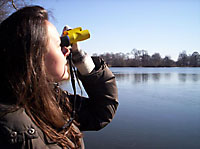

Home | Pet Adoption | Calendar | News | Archives
Brooklyn Tails - Pet News! From Brooklyn's Prospect Park to New York's Central Park
 To casual observers, they may look merely like brave souls braving the cold armed only with binoculars. But each year, between mid-December and early January, urban bird watchers in New York and other North American cities are actually making an important contribution to science They're participants in the National Audubon Society's annual Christmas Bird Count (CBC), an important contribution to data about North American bird populations. This year marked the 108th CBC since it was first established on Christmas day of 1900 as a more humane alternative to Christmas bird hunting competitions-originally, the "count" was a competition for how many birds could be shot. Today, the Audubon Society divides the continent into regions where field parties led by expert birders spend a day recording every bird seen and heard within a specified 15-mile diameter circle. Anyone can register to be part of their local field party, regardless of previous birding experience. In the field, counters walk along a predetermined route, staring intently at their surroundings through binoculars. For those new to the count, birds are identified by comparison against images and descriptions in field guides, while veterans can often identify a bird within moments of spotting it. While including novice birders in the count increases the amount of data that can be collected, it also leaves room for questions of accuracy. "Prior to the 1980's, the scientific community was reluctant to use these types of datasets... all this big scary observer variability on top of how different weather can be through December from one year to the next affects how birds are counted," says CBC director Geoff LaBaron, "but because its such a big dataset with the same thing every year- same time, same places, same people- in the long run, those wobbles in the database even out... in the last 20 years, the scientific community has embraced these datasets."  Regular CBC participants like Marie Winn, author of Red Tails in Love: a Wildlife Drama in Central Park, realize that numerical precision is not essential. "How do you know whether the Titmouse you just observed didn't fly over to the next circle to be counted again? You really don't... you just want a feeling of magnitude. Are there hundreds in this area or is there just one?" As for rare bird sightings, Ms. Winn says, "We air on the side of caution... for middle ranking birders it's easy to make a mistake. It's great to have a sketcher or photographer with you when a rare bird is spotted...but for a very reliable birder that everybody knows, their identifications are enough." The annual bird data collection has now evolved into a process critical to science. "The data is used to spot trends in migration patterns, population growth and decline, and now you can even make statements about global warming," explains Susan Elbin, senior research scientist and avian ecologist at the Wildlife Trust. "Spotting a bird that was never so far north 20 years ago tells us something about changing environments". Christmas Bird Count data has been used here in New York City to map significant range expansions of the Rock Dove, fondly known to New Yorkers as city pigeons. In recent decades, new counts like the Great Backyard Bird Count led collaboratively by the Cornell Lab of Ornithology and the Audubon Society have also realized the importance of the amateur birding community, reinforcing the benefits of what's known as citizen-science. Mr. LaBaron says, "What we know of most bird species worldwide has come from people who just love birds...Ornithology is the field that best illustrates the importance of citizen science". This year's CBC results and information on next year's count can be found at: http://www.audubon.org/bird/cbc/Becky Fried is an avid New York City birder studying Earth & Environmental Science Journalism at Columbia University. Have local bird news and unusual sightings to report? Email Ms. Fried at Rf2123@columbia.edu. |